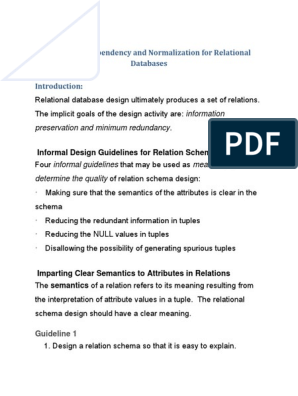0% found this document useful (0 votes)
6 views3 pagesLecture 1
The document discusses database design methodologies, highlighting the Bottom-up and Top-down approaches, with a preference for the latter due to its practical advantages. It outlines design guidelines for relation schemas to avoid semantic ambiguities and update anomalies, including insertion, deletion, and modification anomalies. Additionally, it emphasizes the importance of avoiding NULL values in attributes and ensuring proper relationships between schemas to prevent spurious tuples.
Uploaded by
Subham GarainCopyright
© © All Rights Reserved
We take content rights seriously. If you suspect this is your content, claim it here.
Available Formats
Download as DOCX, PDF, TXT or read online on Scribd
0% found this document useful (0 votes)
6 views3 pagesLecture 1
The document discusses database design methodologies, highlighting the Bottom-up and Top-down approaches, with a preference for the latter due to its practical advantages. It outlines design guidelines for relation schemas to avoid semantic ambiguities and update anomalies, including insertion, deletion, and modification anomalies. Additionally, it emphasizes the importance of avoiding NULL values in attributes and ensuring proper relationships between schemas to prevent spurious tuples.
Uploaded by
Subham GarainCopyright
© © All Rights Reserved
We take content rights seriously. If you suspect this is your content, claim it here.
Available Formats
Download as DOCX, PDF, TXT or read online on Scribd
/ 3






































































































